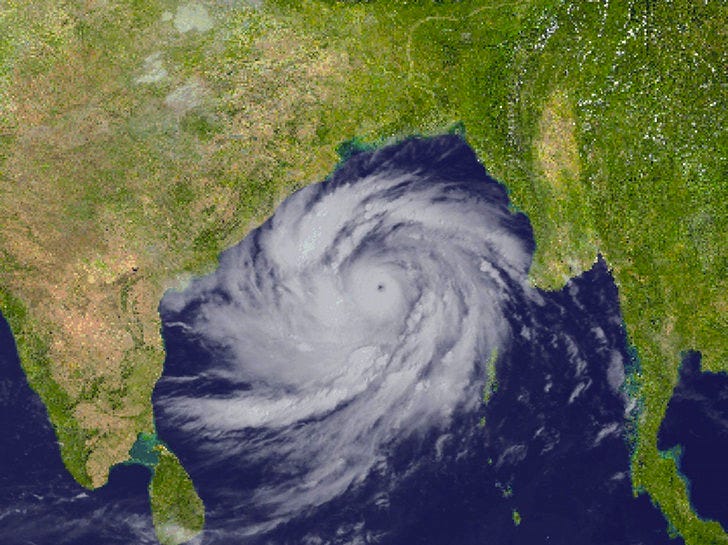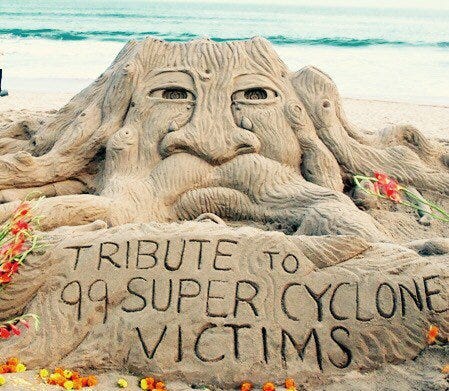Invisible Success
How the Indian State of Odisha Transformed its Fate for Catastrophic Tropical Cyclones
Odisha’s tryst with severe cyclones
In the autumn of 1999, Odisha, India's coastal state of Odisha that boasts 480 kilometers of shoreline along the Bay of Bengal on the east coast, bore the brunt of one of the most devastating tropical cyclones in its history. Dubbed the "Super Cyclone," it presumably earned its name due to its massive wind speed and sustained landfalls that ravaged 14 districts of the state, impacting nearly 19 million people. Unfortunately, the cyclone also resulted in close to 9000 deaths1. It left the entire region without electricity, with people trapped within their homes (if not already destroyed), facing shortages in essential supplies leading to skyrocketing prices, and with roads and other infrastructure decimated. The trauma inflicted upon the affected communities by the cyclone is challenging to articulate.

Fast forward 14 years to another autumn day in 2013, when a tropical cyclone named Phailin, measuring as massive as the 1999 Super Cyclone, made landfall in Odisha. However, the impacts were remarkably different from those experienced 14 years prior. The cyclone affected a larger geographical area than the 1999 Super Cyclone but claimed 44 lives (one too many!)2, magnitudes of order less than the previous one. The difference in impacts between these two very similar cyclones, 14 years apart, underscores the transformative journey that the state of Odisha had taken in effectively reducing disaster risk.
Drastically Different Outcomes
The aftermath of severe natural hazards, even with relatively minor devastations, offers little room to deem anything as unequivocally successful. The inherent unpredictability and unfortunate outcomes associated with such events make labeling them as “successes” challenging. However, the notable improvement in resilience against major cyclones occurring 14 years apart is a significant achievement deserving recognition. The struggle to reconcile the notion of success within the broader context of disaster often makes effective risk-reduction efforts invisible.
Analogously, in sports like football (or soccer) and cricket, no news regarding the goalkeeper or wicketkeeper typically signifies favorable performance, while any news about them is most likely about missed opportunities or errors. Similarly, news coverage during natural hazard events typically focuses on the unfortunate consequences, leaving advancements in disaster preparedness and response invisible in the public discourse.
In that context, this essay intends to explore what success might mean in disaster risk reduction and the inherent invisibility of such successful activities, leaning on the experience of tropical cyclones in Odisha.
What is success in disaster risk reduction?
Defining success in risk reduction activities is complex due to their multifactorial nature. However, as the term implies, these activities are geared towards mitigating risk. Depending on the approach employed, the degree of risk reduction may vary. In theory, as discussed in a prior essay, risk reduction initiatives target minimizing both exposure and vulnerability to natural hazards. This entails reducing the number of individuals and assets exposed to the geographical extent of potential hazards and their susceptibility to such events.
Following the Super Cyclone in 1999, Odisha established the "Odisha State Disaster Management Authority," the first state-level agency in India solely dedicated to disaster risk management. Interestingly, this agency predates the national-level agency, the "National Disaster Management Authority," which was formed in 2005. With this institutional focus, Odisha could prioritize attention and investments towards reducing risk across the state. Collaborating with various non-governmental organizations, citizen groups, and international bodies, the agency led numerous initiatives, such as constructing cyclone shelters, reinforcing coastal embankments, and devising evacuation plans. Additionally, it implemented an early warning system and engaged community groups to enhance awareness and facilitate swift responses. Annual mock drills are conducted in the state's coastal districts to educate residents on cyclone preparedness and response measures.
These efforts led to significantly lower impacts from the 2013 Phailin cyclone than the 1999 Super Cyclone. Communities were well-prepared when the early warning system was activated, thanks to ongoing awareness-raising efforts. Nearly one million people (one-fifth of the population of New Zealand - the country where I live now!) were successfully evacuated to safe shelters. The scale of this evacuation is noteworthy and underscores the preparedness of agencies, communities, and individuals alike. Relating this to the theoretical framework, the early warning system and evacuation measures effectively decreased exposure to the cyclone. Simultaneously, access to secure shelters and individual preparedness fostered through mock drills and awareness campaigns reduced vulnerability. Consequently, when the hazard event (the 2013 Phailin cyclone), similar in intensity to the previous event (the 1999 Super Cyclone), occurred, the reduced exposure and vulnerability compared to the previous event resulted in significantly minimized impact.
The lingering question remains: was the response successful enough? A Japanese researcher conducted a study in Odisha to investigate the dynamics between disaster management and livelihood security3. Analyzing data from 20 villages in the state's most vulnerable region, home to approximately 13,000 residents, the study revealed that livelihoods predominantly centered around farming, animal husbandry, labor, and plantations. Following Cyclone Phailin, floods wreaked havoc on crops, with around 72% crop loss, resulting in a notable surge in labor activities as villagers endeavored to recover. The loss of crops emerged as the most severe consequence, followed closely by challenges such as contaminated drinking water. The loss of animals was less pronounced, thanks to new practices of evacuating them to higher ground, unseen during the 1999 Super Cyclone. The cyclone also took its toll on household finances, with incomes reducing and food prices soaring, exacerbating the struggle to make ends meet. Moreover, opportunities for employment in nearby areas declined, compounding the community's hardships. Drawing from these findings, the study advocates for promoting disaster-resilient livelihood options, such as climate-resilient agriculture and diversifying livelihood activities, to mitigate vulnerability to tropical cyclones. In a broader context, it highlights the scant attention afforded to livelihood support and security within disaster management initiatives.
Success can be subjective, contingent upon the original goal. If the objective was to safeguard lives, the risk reduction efforts in Odisha achieved nearly perfect results. However, this doesn't imply that every aspect of disaster response and recovery is flawless. In any case, the significant improvements in disaster risk reduction that the state has undertaken are highly appreciable. Response after the 2013 Phailin cyclone should be setting higher standards for themselves, looking beyond protecting life and ensuring other aspects of disaster resilience. This example could (and should) inspire other communities to manage and reduce their disaster risk. As with the previous essay on risk communication, this example of successful risk reduction actions can be a natural experiment for others to emulate.
Making successful disaster risk reduction actions visible
The subjective nature of the success of risk reduction actions can often make it marquee. After all, disasters, by definition, entail things going awry. Nevertheless, if Odisha has taught us anything, it's the power of persistent and coordinated efforts to strive for safer communities during future natural hazard events. One aspect that comes through the Odisha example is community-level engagement, symbolized by the evacuation of one million people. The study from Japan, in fact, reported higher measures of social cohesion, sense of unity, and trust between different stakeholders after the 2013 Phailin cyclone. In the face of disaster, such positive outcomes require relentless work, and it is crucial to recognize and acknowledge these efforts.
The Disaster Analytics for Society Lab at Nanyang Technological University has spearheaded an innovative initiative known as the "Averted Disaster Award." A documentary of the 2022 winners is linked below. This award stems from research4 that introduced a concept called "downward counterfactual analysis." This analytical approach aims to measure the benefits of risk reduction actions by quantifying a hypothetical scenario worse than reality if a specific risk reduction intervention had not been implemented. In essence, it provides a means to assess the tangible impact of mitigation efforts in averting potential disasters.
This research presented a counterfactual analysis of Cyclone Fani, a powerful tropical cyclone that made landfall on the coast of Odisha in 2019. It was one of the strongest storms to hit the region since the devastating 1999 Super Cyclone. Fani's impact was severe across the region, causing widespread destruction and displacement, particularly in Odisha, where it claimed the lives of 63 individuals and affected millions more. The paper, using the counterfactual analysis, suggests that the proactive evacuation efforts led to the saving of an estimated 704 lives in the face of the actual storm event, which was initially predicted to be much more intense. The same analysis predicted an astounding 10,317 lives in the event of a more intense storm scenario. This stark difference underscores the benefits of risk reduction interventions, albeit often invisible.
Closing Thoughts
Recognizing the importance of risk reduction interventions in protecting our communities from severe natural disasters is paramount. However, the success of these actions is often overlooked. While tools like counterfactual analysis provide a means to emphasize their impact, real-life examples such as Odisha’s serve as compelling evidence. By demonstrating tangible benefits, we can potentially sway decision-makers to prioritize initiatives to foster disaster-resilient communities.
Thank you for reading this essay and joining me on this journey of exploration. If you found it interesting and valuable, I would be grateful if you could share it with just ONE friend or colleague who may also find it intriguing. Also, please feel free to share your thoughts; what made you ponder for a second longer than usual?
Sinha, A. (2002). Report on recovery and reconstruction following the Orissa super cyclone in October 1999. Asian Disaster Reduction Centre, 1.
UNDP (2015), Preparing for disaster: lessons from Phailin Response.
Iwasaki, S. (2016). Linking disaster management to livelihood security against tropical cyclones: a case study on Odisha state in India. Intern J Disaster Risk Reduct 19: 57–63.
Rabonza, M., Lallemant, D., Lin, Y. C., Tadepalli, S., Wagenaar, D., Nguyen, M., ... & Lim, T. N. (2022). Shedding light on avoided disasters: Measuring the invisible benefits of disaster risk management using probabilistic counterfactual analysis. UNDRR Global Assessment Report 2022.





Great article, Preetish! I particularly appreciate the analogy to sports, which effectively conveys the challenge of recognizing successful disaster mitigation efforts.
It was a great reading. You're so correct in narrating with a befitting simile - the invisible success. Truly enjoyed it. Looking forward